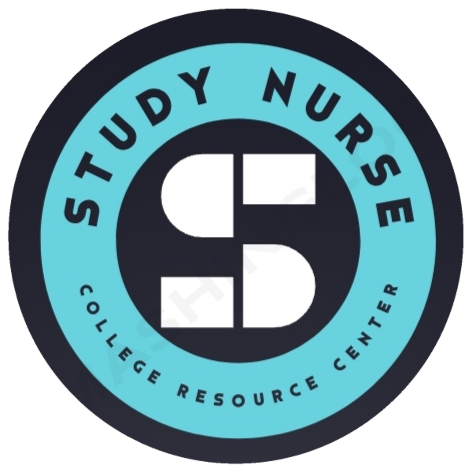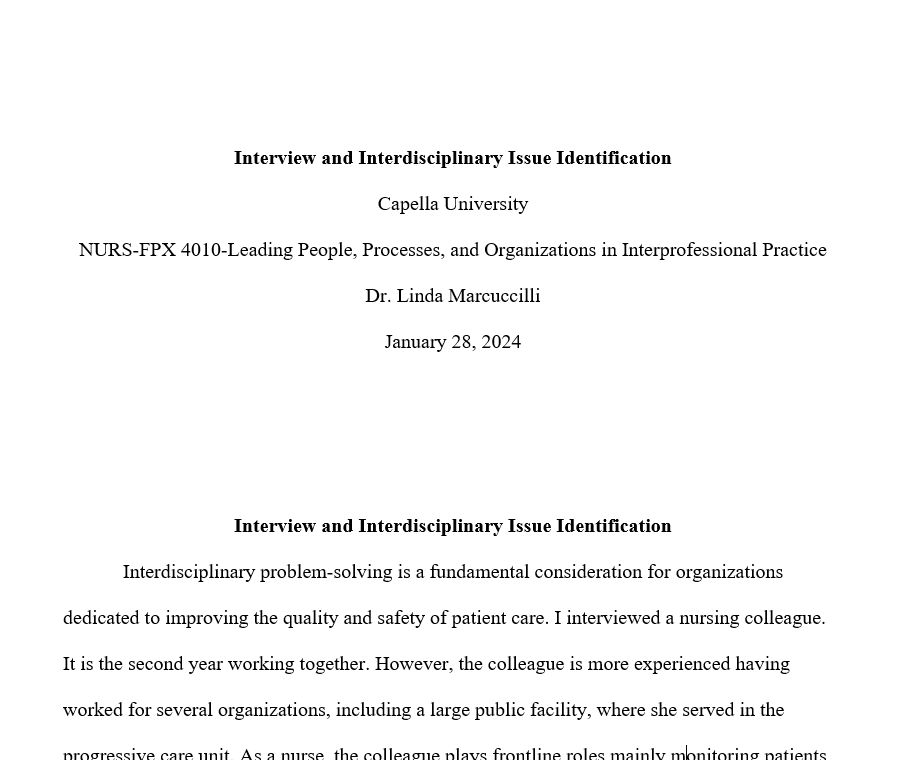NURS-FPX4010_M_Assessment 2-1 Solution.docx
Interview and Interdisciplinary Issue Identification
Capella University
NURS-FPX 4010-Leading People, Processes, and Organizations in Interprofessional Practice
Dr. Linda Marcuccilli
January 28, 2024
Interview and Interdisciplinary Issue Identification
Interdisciplinary problem-solving is a fundamental consideration for organizations dedicated to improving the quality and safety of patient care. I interviewed a nursing colleague. It is the second year working together. However, the colleague is more experienced having worked for several organizations, including a large public facility, where she served in the progressive care unit. As a nurse, the colleague plays frontline roles mainly monitoring patients to achieve desired outcomes.
A qualitative interview provided an opportunity to ask questions and acquire in-depth responses on scenarios within the clinical environment. Similarly, I used a semi-structured questionnaire to allow the respondent to share details about leadership, change management, persistent health issues, and improvements necessary to optimize care outcomes.
The Health Issue
I had a chance to learn more about nursing practice, challenges and interventions necessary to optimize care outcomes. The interviewee identified several concerns such as understaffing, turnover rates, patient falls, and increasing patient acuity. However, an issue that caught my attention was wrong medication administration, considering increased cases of severe complications and premature deaths caused by undesirable drug reactions.
The problem is among key challenges that cause adverse impact on patients, nurses, and the organization. The problem raises questions about the level of vigilance and collective commitment to enhancing medication administration safety (Ahmed et al., 2019). Increased frequency and severity of medication errors increases morbidity, mortality, and cost of health care delivery. The issue also negatively affects brand reputation and financial stability due to lawsuits and declining consumer confidence with the services provided.
Change Theory
Change theories guide leaders and the care team to identify the pathways for implementing meaningful changes. The Plan-Do-Study-Act (PDSA) is ideal for addressing wrong medication administration and related issues. The model clarifies action steps appropriate for sustaining team-based values, behaviors, and attitudes. McNicholas et al. (2019) linked the PDSA model to successful changes where leaders collaborate with the care team to plan, test, observe outcomes, and make adjustments to achieve the best outcomes. Everyone gets the chance to share suggestions on the best practices for enhancing vigilance across the care continuum.
Leadership Strategies to Address Wrong Medication Administration
The right leaders understand the clinical environment, staff, and the various factors that shape the quality and safety of patient care. The transformational leadership is appropriate for initiating collaborative behaviors, values, and attitudes. The leader recognizes the relevance of team-based functions in identifying and intercepting risk factors associated with wrong medication administration (Manias, 2018). The transformational leader uphold excellent interpersonal relations, shared decision-making and governance, and clarity of roles to meet patient demands. The leader also distributes power to enable everyone to visualize a sense of ownership and obligation towards maintaining a safe clinical environment.
Interdisciplinary Collaboration
For interdisciplinary collaboration, the team includes nurses, physicians, clinical assistants, nurse manager, pharmacists, and an administrator. The leader emphasizes the need for trust and mutual interests to make everyone dedicated to preventing wrong medication administration. Another strategy is encouraging collective buy-in where everyone understands the change process (McNicholas et al., 2019). The aim is to enhance the willingness to be part of improvements meant to enhance quality and safety of patient care. Excellent communication is also a priority that eliminates power distances and hierarchical barriers that limit members of the staff from sharing views about recommended strategies.
References
Ahmed, Z., Saada, M., Jones, A. M., & Al-Hamid, A. M. (2019). Medical errors: Healthcare professionals’ perspective at a tertiary hospital in Kuwait. PloS one, 14(5), 17-23. https://pubmed.ncbi.nlm.nih.gov/31116773/
Manias, E. (2018). Effects of interdisciplinary collaboration in hospitals on medication errors: An integrative review. Expert Opinion on Drug Safety, 17(3), 259-275. https://pubmed.ncbi.nlm.nih.gov/29303376/
McNicholas, C., Lennox, L., Woodcock, T., Bell, D., & Reed, J. E. (2019). Evolving quality improvement support strategies to improve plan–do–study–act cycle fidelity: A retrospective mixed-methods study. BMJ Quality & Safety, 28(5), 356–365. https://pubmed.ncbi.nlm.nih.gov/30886118/

